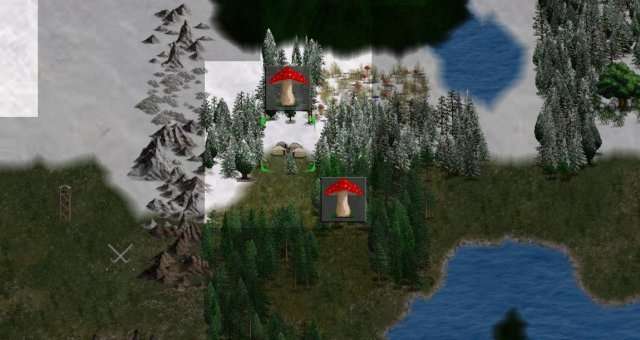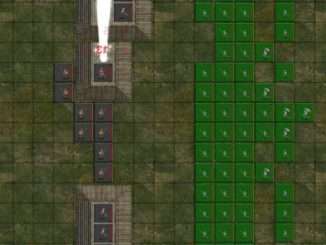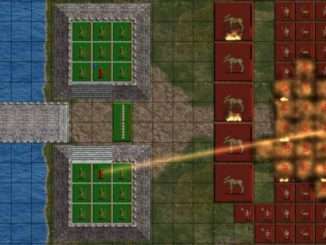
This guide discusses combat in the game.
Guide to Combat
Entering Combat
In CoE5, combat is initiated whenever two armies that are not allied move into the same square. Whoever moves into the square occupied by the army of another player, independent or special monsters is the attacker. Initiating combat uses up all of the army’s remaining Action Points.
A special case of initiating combat is when more than two different factions are involved. The armies of allied players can move through the same squares and stay in the same square and will defend the square against enemy attacks as a single force. In single player games and hotseat games you can defend together with your ally but you cannot attack together. In network multiplayer games it is possible to attack together with your ally.
Combat can be initiated unintentionally if an army moves into a square containing stealthy or invisible units that it cannot see. When this happens, the combat begins as an Ambush. For this reason keeping scouts or other units with Acute Senses or Spirit Sight in an army is important. Whenever an army enters combat, a symbol of crossed swords is placed over the square until the end of the player’s turn when combat is resolved. This makes it possible to move several armies to attack a single enemy army simultaneously.
Combat resolution is displayed at the end of the turn in the Combat Screen. Unless you are playing a network game, in which case the player gets a message and a chance to view the combat at the beginning of his next turn. Combat resolution is automatically handled by the battle AI. The player has no control over the actions of their troops during combat, but will be shown how the battle progresses.
Combat Screen
This section discusses the combat screen interface.
Overview of the Combat Screen
The combat screen has three main components.
- Battle messages (blank space on the left)
- Battlefield (a grid of 28 x 20 squares)
- Controls (upper right corner)
Battle Messages
The battle messages list all of the events that happen during the combat such as hits, misses, spellcasting, how much damage was done and how special abilities affect attacks (e.g. a shield defense reducing incoming damage from a successful hit). The messages can be scrolled with the mouse wheel or the + and – keys.
Battlefield
The battlefield is a grid of squares, 20 squares tall and about 30 squares wide, more for large battles. Depending on the terrain where the battle takes place, there may be obstacles on the battlefield that units must either go around, climb over or destroy.
Controls
In the upper right corner of the Combat Screen there are controls to adjust the speed of the battle replay, which allow the viewer to slow down or speed up the pace or pause the combat view.
- Keyboard shortcuts in battles see in our PC Controls (Keyboard Shortcuts) guide.
Hit Mechanics
Attacks always hit, unless they are modified by a battle affliction or special ability that makes them miss. Afflictions that can cause attacks to miss are lost eyes and blindness. Special abilities that can cause attacks to miss are e.g. Displacement and Bad Sight.
Preliminary Combat Actions
Preliminary combat actions take place before the start of actual combat between normal units.
Prebattle Effects
Prebattle effects take place before the battle begins and are applied before any other actions. They are only applied once.
Assassination
Assassination attacks take place at the very beginning of combat, before any other attacks, and are only available to the attacker. Unless it has multiple assassination attacks, every assassin on the attacking side will make one assassination attack each before the combat begins.
Siege Weapons
If the battle takes place in a city, castle, guard tower or other similar fortified structure (indicated by the catapult icon in the map popup) and one or more sides in the battle has siege weapons, the combat sequence is altered. In siege situations, siege weapons are used exclusively for the first fifteen rounds of combat and siege weapons on both sides will fire at targets that are in range, up to a number of times that the limit of their rate of fire allows within that time period. Siege weapon rounds are counted as combat rounds -15 to -1.
After the siege weapons phase, the combat will proceed according to the normal sequence.
Siege Tunneling
Some monsters have the Siege Tunneling ability. This means they will burrow down below ground at the start of the siege phase and then surface near the enemies often inside the walls when the combat starts.
Monsters with Combat Burrowing ability will continue to burrow at random times during the combat making them difficult to surround for the enemy.
Combat Sequence
The combat sequence section describes what happens once combat begins and in what order. The combat sequence is followed every round until the battle has ended.
Battle Fatigue
Every combat round, battle fatigue is checked first. The start of battle fatigue damage depends on the size of the engagement, but it can never happen before combat round 100. In very large battles, battle fatigue may kick in significantly later than round 100.
Once units start taking battle fatigue damage, each unit takes (1 + nbr of battle fatigue rounds) armor negating magical damage each round. This means that the damage increases every combat round and the most likely winner is the side with the single highest HP unit on the field.
15 rounds before the battle fatigue sets in, regeneration fatigue will set in and dead units will no longer be able to regenerate even though they might have taken too little damage to be irrevocably dead. If their side wins, they will get some rounds after the battle to regenerate, giving them another chance of rising from the dead.
Remove Clouds
The second phase of the combat sequence is removing cloud effects from the battlefield (poison cloud, disease cloud etc). Each cloud effect on the battlefield has a 50% chance of being removed.
Move All Units
All non-stationary units on the battlefield move one step. Attacker moves first.
Move Fast Units
All Fast units on the battlefield move a second step. Attacker moves first.
Check for Fear Effects
If there are units that Cause Fear on the battlefield, Fear is applied to all units facing them. Any units that fail a Morale check will become panicked and run away from combat. Panicked units will start moving toward the edge of the battlefield and will not fight enemies, unless the enemy is blocking their retreat. Once a panicked unit moves off the edge of the battlefield grid, it is removed from combat. Any units on the victorious side that ran away from combat will return after the battle. Any units that ran away from the losing side are lost.
This means that fearsome units are an important tactical asset and force multiplier. They may be pivotal in winning a battle for a small force facing many times its own number.
Determine Attacks & Set Initiative
In this phase, the battle resolution sequence determines which weapon each unit will use to attack. Most units only have a single weapon and they will use that. Some units may have more options and weapons whose use is conditional on some other weapon not being used (see section Weapon Types). Once the attack to be used has been determined, the unit is assigned an initiative value. The unit’s initiative value is the initiative value of the weapon he uses. There is no random component to the determination.
Tip
A spearman attacks with a spear, which has an initiative value of 6. Thus his initiative value is always 6 unless he changes the weapon to something else.
Magic Wands
Any units in possession of magic wands make their wand attacks now (if they decide to use it), before other attacks.
Perform Attacks in Initiative Order
All units perform their attacks on available targets according to the order of their initiative value. Units with the same initiative are resolved in random order within that initiative value. Units with highest initiative attack first.
Apply Persistent Effects
Persistent unit effects are applied to those units which are under the influence of such an effect. For example, damage from burning or poison, healing from regeneration etc. are applied at this stage.
Apply Battlefield Effects
Battlefield wide effects, such as Wall of Torment attacks and poison clouds are applied here.
Check If Battle Is Over
The battle is over when one side no longer has any troops on the battlefield. If the battle is over, run the combat sequence for another 75 rounds to make sure fire, poison and similar effects get to run out. Battle fatigue damage is not applied during these clearance rounds
On the Battlefield
This section describes some of the conditions on the battlefield and related mechanics in detail.
Unit Placement
Units are placed on the battlefield in opposing rows, the defender on the right and the attacker on the left. Units are placed according to their rank designation.
If the combat is an ambush, the party that blundered into the ambush will not be placed properly for battle, instead they will fight in the line that they were marching in. The ambushing forces will be distributed around it, usually with most troops in the vicinity of the front of the line, in order to strike down the commanders quickly.
Obstacles
The terrain of the battlefield is determined by the terrain of the square where the battle takes place. There may be natural obstacles, such as rock formations (common in mines and mountains) or maybe trees and bushes (common in forests).
If there are covered locations suitable for archers on the battlefield, back and middle rank units from the defender may be placed behind them at the start of battle. The attacker must usually go around or over an obstacle in order to attack the unit taking cover. Obstacles can be bypassed by wall climbing, ethereal, flying or giant sized units.
All obstacles have stats and Hit Points and can be attacked. Once the obstacle’s Hit Points are reduced to zero, it is destroyed and can be passed normally. Hold down the tab key to hide units if you need to inspect a terrain feature that is below a unit.
Spellcasters
Any spellcasting commanders and units will usually cast a spell in their repertoire if they are able to do so. If they have no effective spell available they do nothing unless engaged in melee or they have other options such as ranged weapons.
Spellcasting is very difficult in melee and (most) spellcasters are automatically placed in a back row if possible. The chance to successfully cast a spell while engaged in melee is 25%.
The effects of spells are usually applied immediately (subject to possible magic resistance, strength resistance or morale checks). Some spells cause effects that are applied over several rounds of combat (e.g. poison) or effects that last for life (e.g. curse).
Ranged Weapons
Units with ranged weapons will fire them at the enemy if they are in range. If they are not in range, the units will move toward the enemy in order to acquire range.
Different ranged weapons have a different rate of fire. Bows and longbows are fired every combat round. Crossbows are slower and take one combat round between shots to reload. Arbalests (heavy crossbows) require two rounds to reload.
Mundane missile weapons like bows do half damage (rounded up) if they shoot at ranges greater than half the maximum range (rounded up). Units standing on walls have +1 range, or +2 if the walls are high (2 squares of walls in front of the battlement).
It is impossible to fire normal ranged weapons in melee, so if ranged weapon units are left without an infantry screen and engaged in melee, they will use their secondary weapons (usually a dagger or another less powerful weapon) for defense. For this reason you should make sure your ranged units always have plenty of infantry cover.
Front Ranks (Melee)
Melee units will attack as many times as they have weapons. Each weapon may strike a different unit within range. Some weapons may be used only if some others are not.
Note
In combat units may make attacks even when the enemy is completely immune, in which case the attacks cause no damage at all.
Summoned Creatures
Some spells summon monsters to aid the caster in combat. Some magic items may also act as summoning spells and summon monsters to aid the bearer, either at the beginning of combat or even every combat round. Summoned creatures appear instantly and any surviving summoned creatures will vanish after the battle is over.
Summoned creatures do not act immediately. They only begin to act on the round after they appear, at which point they are indistinguishable from other units and act according to the normal combat sequence.





Be the first to comment